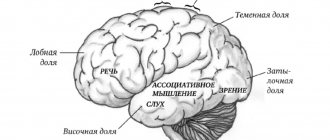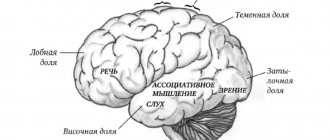Apperception is a property of the psyche that contributes to the conditional perception of objects in the surrounding world, according to one’s experience, interests, worldview and views. The concept of apperception means meaningful, attentive and thoughtful perception. It happens that different people observe the same thing, but they all may have a different impression of what they saw. This happens due to their way of thinking, past experience, fantasy and perception - this is called apperception. It is different for all people.
Apperception is a concept in psychology that describes a mental process that provides a relationship between the perception of objects and phenomena from a person’s past experience, his knowledge, orientation, motives and goals, current core activity, personal characteristics (emotions, attitudes, etc.).
Apperception of perception is a meaningful process of contemplating things and phenomena of the surrounding world. Apperception is greatly influenced by a person’s interests and inclinations, his character, abilities, emotional state, social status, behavior and other factors.
Apperception is also influenced by mental state, current attitude, assigned tasks and goals of activity.
Examples of the concept of apperception: a person specializing in apartment renovations, coming to a housewarming party, will first of all notice all the subtleties of the repairs made; if the work was not done very well, then he will see it, although to other people it will seem that everything is fine. Another example of apperception: a person who comes to a store for shopping will be guided by what he needs to buy, and not by the entire assortment of goods.
Apperception is a term in psychology introduced by G. Leibniz. The concept of apperception according to G. Leibniz contains the mental processes of memory and attention, and is a condition for developed self-awareness and cognition. After the era of Leibniz, the concept of apperception was studied by many psychologists and philosophers - I. Kant, W. Wundt, I. Herbart and others.
I. Kant, unlike Leibniz, did not limit apperception to the highest level of cognition, but believed that it determines combinations of ideas. He distinguished between empirical and transcendental apperception.
I. Herbart characterized apperception as a process of acquiring knowledge in which the perceived characteristics of a new object or phenomenon are associated with existing knowledge stored in experience. Also, I. Herbart introduced the concept of “apperceptive mass”, which designated previously acquired knowledge. His presentation demonstrates that understanding and learning depend on the awareness that there is a connection between recent ideas and existing knowledge.
W. Wundt considered apperception to be an active intellectual process of selecting and structuring internal accumulated experience, a center of attention in the field of consciousness. V. Wundt actively used this term in experimental psychology, but in modern times, the concept of apperception is found less and less often. But the concepts inherent in this concept are very important, so attempts are being made to introduce this term into repeated use in science.
The term “apperception” is used more by representatives of cognitive psychology. Along with the existing concept of apperception, the American psychologist Bruner also identified the concept of social apperception, which is understood as the process of perception of material objects, social groups, individuals, ethnic nationalities, peoples, and so on. Bruner found that subjects of apperception can sufficiently influence personal assessment.
Social apperception allows individuals in the process of perception to be more subjective and biased than in the perception of objects or some phenomena.
Social apperception of perception is the influence of a group, their opinions and moods, the course of joint activities on a person, on his assessments.
The origin of apperception is biological, cultural and historical. Apperceptions are both innate and acquired at the same time. The integrity of human apperception can only be explained through the unity of the world and the structure of man. Neurophysiological data on the distinction between sensations and perceptions is consistent with psychological knowledge about humans.
What is apperception?
Apperception is a mental property that represents the conditional perception of external objects depending on a person’s life experience, his worldview, moral and ethical beliefs, occupation, interests, needs, expectations and other factors. Apperception means that a person recognizes a familiar object with certain properties or a scene from life in the image he sees.
Simply put, apperception is one of the basic properties of human perception. Just as our eyes focus on a specific object to get a clear image, our brain focuses on a specific image to fix it in our perception. Apperception is not innate, but is formed in a person as he accumulates life experience. Today we will talk about what it is, how it manifests itself and what significance it has in our lives.
The term "apperception" comes from the Latin words ad (to, approach) and percipere (to perceive) or perceptio (perception). German philosopher Gottfried Leibniz is considered the founder of this concept. He divided perception into two components:
- perception is a sensation that has already been perceived, but does not yet have meaning;
- apperception - a sensation that has been perceived and identified.
It is worth noting that in modern psychology the term “perception” is used to refer to perception as a whole, and not just its non-significative component, as in Leibniz.
By looking at the same outlines, people can identify different objects within them. Many optical illusions are based on this phenomenon, as well as psychological tests such as the Rorschach test or the Holtzmann Inclot test (which is an improved version of the Rorschach test).
Perception and apperception
A person perceives the world around him. How exactly does he do this? One can observe not only apperception, but also perception. What is the difference between them?
- During apperception, a person perceives the world consciously, clearly, depending on previous experience, his knowledge, his goals and direction of activity. This is an active form of studying the world around us in order to expand our own knowledge and experience.
- In perception, a person is “not involved.” This is also called "unconscious perception", when the world is perceived simply, vaguely, independently.
The perception may have no meaning or meaning. A person sees and feels the world, but the information is so insignificant that he does not pay attention to it and does not remember it.
In apperception, a person acts consciously, looking for something in the environment that will help solve a cognitive problem.
A simple example of perception and apperception is a sound that is heard next to a person:
- If a person pays attention to it, analyzes it, becomes aware of it, remembers what happened, then they talk about apperception.
- If a person hears it, but does not pay attention, does not try to recognize it, this is called perception.
Perception and apperception are interconnected. There are often situations when a person first does not pay attention to certain phenomena or persons, and then is forced to restore them when, in the process of apperception, he realizes the importance of remembering them. For example, a person knew about a certain program, but did not watch it. After meeting an interesting person, a conversation about the show begins. A person is forced to remember information that he previously did not pay attention to, and now it is made conscious, understandable and necessary for him.
Social perception is characterized by the perception of another person, the correlation of conclusions drawn with factual factors, awareness, interpretation and prediction of possible actions. This is where the assessment of the object to which the subject’s attention is directed occurs. The most important thing is that this process is mutual. The object, for its part, becomes a subject who evaluates the personality of another person and draws a conclusion, gives an assessment, on the basis of which a certain attitude and behavior pattern is formed.
The functions of social perception become:
- Self-awareness.
- Study of partners and their relationships.
- Establishing emotional contacts with people whom a person considers reliable and necessary.
- Willingness to work together in which everyone achieves some success.
What you imagine in your mind when you hear this word is how you react and see the world around you. The world itself is neither good nor bad. He is what you think he is.
Here you can hear: “What to do with people who constantly bother, offend, betray? When you calm down after a negative situation or breakup, why not look at your offender with a smile? After all, there is something good about another person who you previously liked and had a pleasant experience with in your life. As long as you look at your offenders with a smile, they will not be able to hurt you or deprive you of happiness. In fact, you can take the qualities that you were once attracted to and cultivate them in yourself. While you try to avoid your offenders, try to forget them, they hurt you every time you remember them. You spend your energy trying to escape instead of just not reacting and growing, becoming better and stronger.
If you don't like something, just change your attitude. Stop being afraid, stop hiding, stop running away. Start not reacting to unpleasant things, but notice them and spend time only on what makes you happy. In the end, the world depends on your idea of it. She can be beautiful and happy if you focus on that. Or it can be drab and boring if you spend time feeling depressed. You must see the world as it is.
Apperception is a state of a person in which he perceives and analyzes the surrounding reality
Different people - different perceptions
In philosophy, the transcendental unity of apperception is a concept introduced by Kant. He first used it in the Critique of Pure Reason.
The philosopher distinguishes between primary and empirical apperception. In life, we often encounter a situation where people, being participants in the same events, can talk about them differently. It depends on the person's personal perception, the influence of adherents and religion on the person, or specific experience. And it may seem that in two completely different cases we are talking about the same thing.
Unity and identity
The environment in which a person pays the most attention depends on the things to which he pays the most attention. His perception of himself is determined solely by his own opinion, attitude to circumstances and everything that happens around him. Unity and identity in the subject's self-awareness is a necessary condition for cognitive synthesis. It is the transcendental unity of apperception that should cut off all anomalies in the individual’s thinking.
What a person thinks, how he feels about current events - all this determines his emotions, feelings and forms a certain idea, point of view and similar manifestations. Anything can happen in the world that is under the control of the human mind. A concept such as the transcendental unity of apperception presupposes self-awareness, which reveals the way a person thinks about every life event and the world around him without the manifestation of sensory evaluation.
It is important to have tolerance and not be surprised that there are different things in the world at the same time: beautiful and terrible. What does it mean to have tolerance? This is a conscious acceptance of the imperfections of the world and oneself. You must understand that everyone can make mistakes. The world is not perfect. And this is due to the fact that everything around a person may not correspond to his perception.
For example, we want to see someone as a brunette, but he is a redhead. Or the child should be calm and obedient, but he is restless and angry. So, the transcendental unity of apperception presupposes tolerance, which manifests itself in the fact that there is an awareness of the possible inconsistency of other people and the world around one’s own expectations and ideas. The world is what it is - real and permanent. Only the person himself and his view of the world change.
Peculiarities
Perception has certain properties. They can be defined as sensitivity, consistency and thoroughness. The first feature is the different perception of the same object by different people. The reason for this phenomenon is that each person has his own accumulated experience on which he bases his perception.
The second is that, despite changing conditions, the perception of the properties of an object remains relatively independent. The third feature indicates that people correlate all impressions of the environment with various objects and phenomena (blue sky, the sound of a human voice, etc.). Related to subjectivity is meaningfulness.
Previous experience and knowledge are always mixed with new impressions, and on this basis we recognize the object.
It is important to note that it is in the process of developing apperception that many find their meaning of life and existence.
Rational psychology and paralogisms of the mind
The first of the three ideas of reason is the soul as the first unconditional. Rational psychology usually looks for the unconditional (meta-empirical and transcendental) in the absolute subject in order to deduce from it other internal phenomena. But here a “transcendental illusion” arises, and the pretentious theory falls into paralogisms, i.e. vicious conclusions. We are talking about an error that traditional logic calls quaternio terminorum (quadrupling of terms). The inference includes three terms, but if one of them, the middle one, is fraudulently used differently in the two premises, then instead of three, four terms are formed. In traditional psychology, according to Kant, this paralogism occurs when one starts from self-consciousness, that is, the synthetic unity of apperception, and then
transform it into a substantial ontological unity.
It is obvious, however, that substance as a category can be applied to the data of intuition, but not to self-consciousness. “I think” is the form and pure activity on which the categories themselves depend; it is the subject, not the object of the categories. So rational psychology was born out of a misunderstanding. The unity of consciousness as the basis of categories is taken to be the intuition of the subject taken as an object, and then the category of substance is incorrectly applied to it. But intuition characterizes the unity of the thinking subject, and the category of substance is not applicable here. The subject of categories is not directly related to the object: in order to think them, one must take as a basis pure self-consciousness, which has yet to be explained. In short, we think of ourselves as thinking beings, but we know nothing about the noumenal. We recognize ourselves as phenomena determined in space and time, but the ontological substrate of each of us - the soul as a metaphysical "I" - slips away. Attempts to break out of the phenomenal world almost always end in paralogisms.
Examples of apperception
To better understand apperception, let's look at a few examples that we often encounter in everyday life:
- When we communicate with a person whom we do not trust for some reason, behind his every word we see a lie or an attempt to manipulate;
- Sometimes, instead of a word written in capital letters in a store window or on a sign, we may misunderstand another word that relates to our current needs or expectations;
- everyone quickly identifies images related to their profession and hobbies, sometimes finding them even where they should not be;
- a choreographer in everyday life notices that some people move smoothly, while others move rather awkwardly (although to any other person their movements look the same);
- when we are looking for a certain thing among many others, we do not immediately find it, but then we do not lose sight of it, because we have fixed its image in our minds;
- a hungry person is more likely to observe food-related images (such as cafe and restaurant signs).
You may have seen humorous texts in which all the letters except the first and last are mixed up. It’s easy to read such a text, and sometimes you don’t even notice how mutilated the words are. This is a perfect example of apperception because this "trick" only works for the native language. But if you read English fluently, you will find it more difficult to read English text with jumbled letters than Russian.
Apperception is present always and everywhere - in communication, relationships, work, study and even in ordinary observations.
Mechanisms of perception
The methods and tools by which perception is formed are called perceptual mechanisms. With regard to the perception of social objects, a distinction is made between interpersonal and intergroup perception. The main mechanisms contributing to these two types of social perception are:
- identification;
- sympathy;
- reflection;
- Deconcentration;
- Causal attribution;
- attraction;
- social understanding.
Let's look at them in more detail.
There are several definitions of identification. It is the conscious or unconscious way in which one person understands another by making him like himself, as well as the ability to step back from one's own position and look at a situation from the other person's point of view.
To illustrate the latter definition, we can cite the words of the famous industrial magnate Henry Ford: “The secret of my success lies in the ability to understand the point of view of another person and see things from his point of view.”
Empathy is the ability to understand and empathize with another person's emotional state. The ability to show empathy.
Decentralization means the ability to step out of your own position and look at the situation from the point of view of an outside, disinterested observer, rather than a partner. It is a mechanism for avoiding the influence of emotional biases and is therefore considered one of the most effective tools for getting to know other people.
Social reflexivity is a person’s ability to understand how he is perceived by his communication partners. The completeness and intensity of social reflexivity is directly related to the subjective meaning of the partner.
Attraction (sympathy) is a form of perception, getting to know other people, which involves the formation of a stable positive feeling towards them. Liking is often viewed as the formation of attraction to another person, the result of this process and the quality of subsequent interaction. The intensity of attraction varies from sympathy and friendship to deep affection and love.
Attraction can be stimulated by factors such as
- Spatial proximity (living in the same area, attending the same class, etc.)
- Planning, anticipating and interacting with each other;
- To be in the eye of the beholder;
- Physical attractiveness;
- similarity of worldviews and interests;
- Kindness towards the object of perception.
Another mechanism of social perception is causal attribution. It is the tendency to attribute reasons to one's own behavior and the behavior of others. This phenomenon occurs when the subject does not have sufficient information about another person and replaces it by attributing his own meanings.
Kelly identifies the following types of attribution:
- indirect - means attributing the cause of an event to an external circumstance or situation;
- objective - means attributing the cause to the object to which the action is directed;
- personal - attributing a reason to the person who personally performed the action.
Formation of perception includes the ability of a person
- think in stereotypes;
- define people according to a certain personality type
- use reflexive mechanisms;
- use empathy;
- create forecasts.
Perceptions are often shaped by one's own feelings and experiences and transferred to others.
Types of apperception
Apperception is a complex psychological phenomenon that helps us identify and highlight things that are important to us. There are various manifestations of this phenomenon, which psychologists classify using several approaches. In particular, apperception is divided into two types, depending on their proximity to life experience:
- Transcendental. This term was introduced by Kant to designate the unconditioned apperception originally inherent in human consciousness (apperception of pure reason).
- Empirical. This form of perception is based on accumulated experience.
Depending on whether it is based on some permanent features of perception or on momentary expectations, it is also divided into two types:
- Temporal. It is determined by current expectations, desires, impressions or needs. Although it is not always associated with emotions, it is also often called "emotional."
- Persistence. This form of apperception is determined by life experience, character traits, habits, level of education, professional knowledge and other fixed factors.
American psychologist Jerome Bruner proposed the concept of “social apperception.” He associated this type of apperception with the perception of groups of people. We are talking about how a person perceives a certain social group, what properties he attributes to it, what actions he expects from it, and how he interprets events associated with this social group.
History of the term
The author of the concept is considered to be the German scientist Gottfried Leibniz (1646-1716). True, by modern standards his understanding of what apperception is looks very unusual. He viewed it as a form of activity of the human soul.
Immanuel Kant (1724-1804) introduced the concept of transcendental apperception. From his point of view, apperception could be determined both by a person’s life experience (empirical) and by factors beyond human understanding (transcendental).
The German scientist Johann Herbart (1776-1841), considered the founder of empirical psychology, devoted a lot of time to studying how the process of awareness of perceived sensations occurs. It was he who made the word “apperception” a purely scientific (and not philosophical or spiritual) term. He also introduced the concept of “apperceptive mass,” which characterizes accumulated knowledge.
Wilhelm Wundt also devoted a significant part of his research work to apperception . He viewed apperception as an intellectual process of accumulation, structuring and use of life experience, which is necessary for our consciousness to quickly identify familiar objects and phenomena.
Properties of perception
Perception is characterized by its properties, and experts have identified seven properties:
- Selectivity - when choosing an object, a person focuses his attention on it, for example, on a book in a bookstore, all other objects seem to be relegated to the background;
- Objectivity is the assignment of an object to a certain category, for example, round, cute, green, long, growling, etc. This process may not occur immediately, so it takes time for a person to determine the type of object. Subjectivity influences human behavior - an egg known to everyone does not cause doubts and caution, while a person will be careful with an unknown product;
- Apperception - the formation of an image of an object depends on the mental experience and personal characteristics of a person, i.e. the same object is perceived differently by different people depending on their beliefs, attitudes, values, needs;
- Integrity - this property states that, based on the totality of perceived impressions, the image is always perceived as a single whole. Color or sound alone cannot create it. Movement is an important factor, for example, a fly for a frog will not be perceived by the fly if it is motionless, so it will not hunt it;
- Structurality - this property lies in the fact that perception is not the sum of individual impressions, the image is born from their interaction. A person listening to music does not perceive each note separately, he hears the melody as a whole;
- Persistence is a perceptual property that shows the relative permanence of surrounding objects, for example, the house we live in is made of red brick and is clearly visible during the day. At night, the color of the bricks changes, but the person knows for sure that this is his house, and does not attach importance to the fact of a change in visual perception;
- Sensitivity indicates awareness of objects and phenomena of the surrounding world - seeing a spoon, a person understands what it is used for, which means that perception is not an innate trait, but is acquired during the course of a person’s life.
Apperception allows a person to perceive the world objectively
Bottom line
Through what lens do you view the world? People look at the world each through their own prism. When you hear the word “apple,” some people imagine a green apple, while others imagine a red one. Looking out one window, someone sees stars, and another sees bars. Thus, beliefs, beliefs, principles of “what is good and what is bad” are the prism through which a person looks at the world, which characterizes the phenomenon of apperception. The result is a certain limited perception of the world, ignoring everything else.
This prism forces a person to act in one way or another. Looking through it, a person commits certain actions. Accordingly, there are people who consider it normal to blow their nose in public places, and those who will endure it until they get to the restroom to clear their nose. There are people who consider themselves worthy of becoming rich, despite the fact that they are now living in a cardboard box at a train station, and those who consider themselves unworthy of wealth, even if they have completed higher education and have a roof over their head.
Depending on the set of beliefs, principles, rules, permissions and prohibitions through which a person views the world around him, he allows himself one way of life or another. It can be said that many people do not achieve their goals and desires only because they consider themselves unworthy of having them or unable to achieve them. Of course, if a person considers himself unworthy and incapable, then he will not do anything to achieve his goals. And here it no longer matters who has what capabilities. There are people without arms and legs who earn more money than those who are physically completely healthy.
It all depends on what you believe in, what you are guided by and what you allow and forbid yourself. The prognosis for life with apperception can be either happy or unhappy. It all depends on the eyes of the beholder, who selects from all the information what he wants to know, see and hear.
But if a person changes his usual prism, then his actions, lifestyle, relationships and even his social circle will change. If you want to change your life, change your beliefs, principles, “I allow” and “I do not allow.” All this will inevitably lead to changes in your behavior and the commission of new actions, and these, in turn, will lead to new consequences. And depending on what and in what direction you change, your life will change in one direction or another.
Transcendental unity of apperception
Each person has the ability of transcendental unity of apperception, which is understood as the unification of new knowledge with previous life experiences. In other words, it can be called learning, development, change. A person constantly acquires new knowledge, information, and masters skills. This combines with what has already been learned, creating a new way of looking at yourself, at people, at the world in general.
The transcendental unity of apperception includes three factors:
- Deduction is the extraction of a specific conclusion from general information. Through perception we move on to apperception - the knowledge of the information we need.
- Contemplation is an observation that can then be disassembled and analyzed.
- Imagination is the representation of those pieces of information that complement each other.
A person is mistaken when he thinks that he sees the world around him as it really is. In reality, a person sees everything in a distorted spectrum due to the influence of certain factors on his perception of the world. These may be beliefs about what is good and what is bad, concentration on some ideals and rejection of others, prejudices and complexes about certain phenomena in life. There are many factors that contribute to misperceptions of the world. How does this manifest itself in the outside world?
People are known to make decisions in advance and then create conditions in which their previous conclusions are confirmed. A person consciously notices cases that confirm his suspicions and expectations. He notices only what he wants to see - examples that confirm his prejudices. For example, a man who suspects his woman of cheating will see evidence of cheating in every interaction with other members of the opposite sex. Such a man will see not simple business communication between his woman and another man, but clear signs of flirting, which will ultimately lead to sex. He sees what he wants to see, and not what actually is.
Stereotypes play a role. This is very clearly manifested in the desire to please every man. For example, a woman brings a man beer because she believes that all men drink, given that her own first marriage broke up due to alcoholism. The question is, why persist in a stereotype if it has already destroyed previous relationships? Unfortunately, this is what many people do. In their normal state of mind, they may condemn or encourage certain actions of a person, but when it comes to winning the favor of another person, they forget that stereotypes can play a cruel joke if you use them. What do you think will destroy a woman's marriage with the man to whom she brought beer? That's right, because of alcoholism, as in the first case.
A person, when criticizing another person, speaks not about him, but about what he saw in him. He criticizes those qualities that are inherent in himself. And he reacts to them negatively because he cannot stand these qualities in himself. A person is always irritated by what he himself has in others. A lot of judgment is a sign of a principled person. The more principled you are, the more you judge others. This game is the great defense mechanism of the human ego. Selfishness never allows its owner to see his mistakes and shortcomings, because this kills him. By covering up the imperfections of the world and the people around us, the ego protects a person from studying his own shortcomings.
Another big distortion of the worldview is the so-called errors. It is more common to say that something was done wrong than to look at the situation from a different angle. In fact, there are no mistakes! They simply don't exist! There are only situations that people consider mistakes. But they are not errors in themselves.
Examples of the influence of the past on the present
Previous knowledge about the world and its objects is always revealed. This is not so easy to illustrate. Let's say you are sitting in a chair, and next to you a child is assembling some kind of structure from Lego cubes. If you dozed off, having already seen what kind of bastion had appeared under his hand, and while you were sleeping, he took it apart into small, but still connected parts, then almost without difficulty, when you wake up, you will be able to remember what this or that part belonged to.
Download for free: 5 books that will change your life! ♡
We recommend: Abstractions and abstract thinking
Apperception is a direct consequence of learning. If we did not have this property, it is unlikely that we would be able to quickly draw parallels and understand how to work with a new stimulus. Having read a sentence with difficulty once, we would learn again each time that letters form words, and each word carries its own meaning. We would have to give meaning to external and internal stimuli again and again.
By learning the meanings of sensory signals, we acquire a network of associations that make it easier for us to interpret stimuli from the outside world. For example, when you hear a balalaika, you can immediately draw a parallel with the traditions of the Slavs, their culture, and specifically with their dances and entertainment. Simply put, our understanding of the world is influenced by the interaction of two structures:
- Knowledge.
- Feelings.
What we know about an object is superimposed on what we feel in the process of direct perception of it, and we get an image of the object at that moment. This helps us read, write, assign people and phenomena to one group or another, but it also leads to multiple misconceptions and problems.
Download for free: 5 books that will change your life! ♡
Apperceptive distortion
Apperception in psychology is a complex process that requires careful study.
To make tests as effective as possible, experts use the following forms of distortion:
| Name | Description |
| Simple projection | The state of affect that occurs under certain conditions and circumstances greatly influences and can even change the formation of apperception. A person has feelings, character traits and emotions towards the people around him. He can transmit them to people around him. Simply put, feeling hatred towards one person means that he is as unloved as he is. |
| Sentimentalization | A specific direction in the psychological treatment of a person. The main goal of therapy is to change the client's behavior. |
| Externalization | A condition in which a person's inner world is analyzed using his individual characteristics. |
| Rear projection | A person ascribes to himself many qualities that he does not possess, but really wants to acquire them. Contact with other people in this situation is weak. A person attributes negative qualities to them. |
Forms of Apperceptive Distortion
Perceptual distortions can lead to hallucinations that can be distinguished from each other. This happens because the person makes voluntary efforts. He unconsciously provokes them and gets great pleasure from it.
Manifestations
Apperception is a complex psychological process that relates to the perception of phenomena, objects, and people. Without it, many other psychological processes could not take place.
When a person comes to a seminar where an uninteresting topic is discussed, the incoming information is partially absorbed. If the lecturer changes the topic, touches on a question that interests a person, the individual will immediately pay attention to the narrator, begin to listen, and assimilate the entire flow of data. In this situation, the first part of the lecture took place with apperception, but the second did not.
Apperceptive hallucinations
Apperception in psychology is not always ideal perception. Sometimes the perception of the surrounding world is distorted and associated problems appear, including hallucinations. In most cases, the basis is a psychological deviation of the individual.
Apperceptive hallucinations are perceptual disorders in which numerous images without real objects appear before the eyes. They can be visual, auditory, tactile or olfactory.
A characteristic feature of apperceptive hallucinations is the mechanism by which they arise. Non-existent images or sounds appear when a person wants them. He forces himself to experience these feelings, enjoying the situation.
Many patients diagnosed with schizophrenia find themselves in this situation. In the initial stage of the disease, the patient forces himself to experience auditory hallucinations, which after some time become real for him. He hears sounds in and around his head.
There are different types of apperceptive hallucinations:
| Name | Description |
| Abstract phonoremia. | A person's own thoughts are taken away and replaced with someone else's ideas. |
| Concrete | A condition that occurs when a person's own memories appear before the hallucination. |
Types of apperceptive hallucinations
Child Study Test
Apperception in children is tested using special tests that are suitable for ages 3-10 years. The methodology in psychology was created by the scientist Bellak. During testing, the child is shown various images of animals engaged in certain activities.
He needs to tell the story that comes to mind when looking at these cards. What animals are shown in the picture, what they are doing, what they are doing and with whom. After the story, the psychologist asks clarifying questions to the child so that a complete picture emerges. It is important to show the images to children in a certain sequence during testing.
This examination technique allows us to identify the child’s ability to perceive the world around him, namely:
- existing needs and motives;
- internal conflicts, if present;
- fears, phobias;
- fantasies;
- attitude towards peers, methods of behavior;
- presence of defense mechanisms;
- communication with close relatives (brother, sister, mother, father, grandmother, grandfather).
Apperception helps to realize, comprehend, and reflect on the current reality, using skills and knowledge from the past. In the case of children, these perceptions need to be corrected so that in the future they have correct concepts about the world around them.
Thanks to apperception, a person is filled with experience that will be useful to him in his future life. In psychology, a phenomenon is formed depending on the assessment that an individual gives to the current situation. The final opinion, of course, will differ from the perception of other people. That is why the world around us is so diverse for each individual.
Development of perceptual skills
Most psychologists are of the opinion that a smile on the face of another person is enough to establish mutual relationships and friendly communication. Smiling is one of the most important criteria for the development of perceptual skills.
Facial expression gives a lot of information about a person's feelings. By learning to smile correctly and control your emotions, you can significantly improve your perceptual skills.
Ekman's technique helps to distinguish emotional manifestations as accurately as possible and develop perceptual skills. Each person has certain zones where basic emotions are expressed (sadness, joy, fear, anger, rage). We are talking about the forehead, eyes, mouth, chin and nose.
If necessary, apperception skills can be developed









